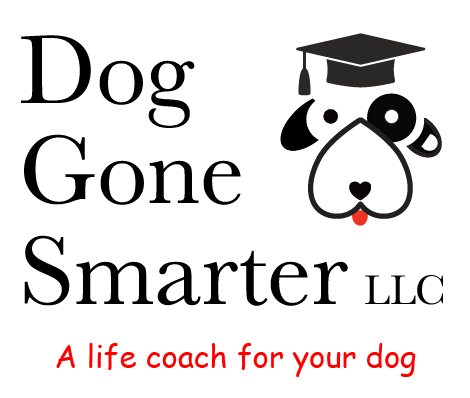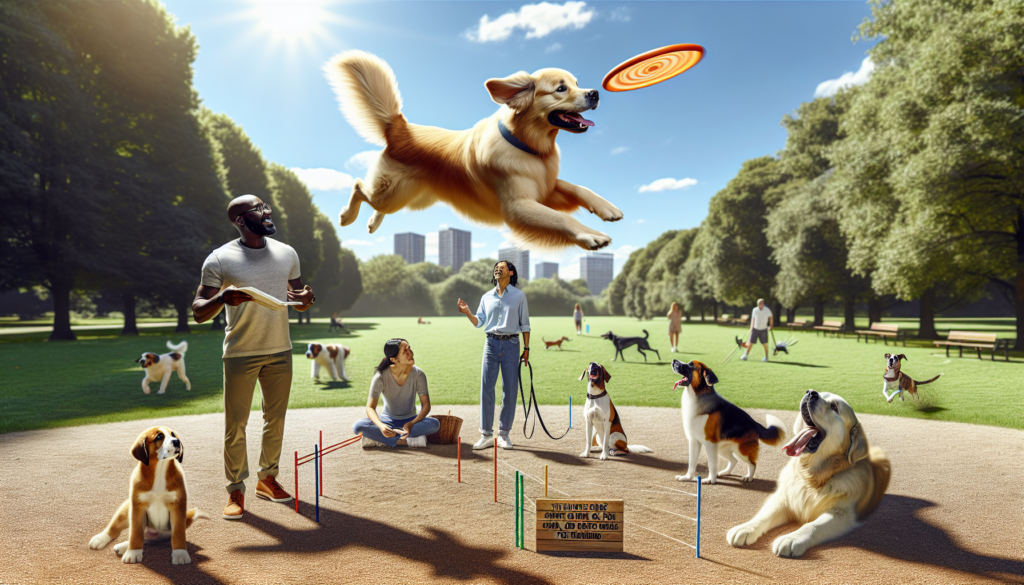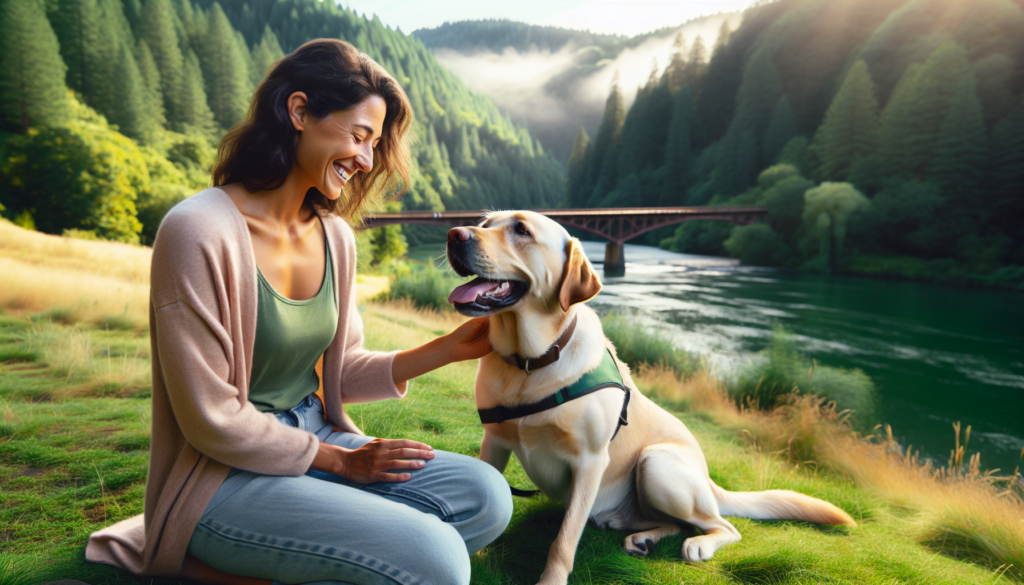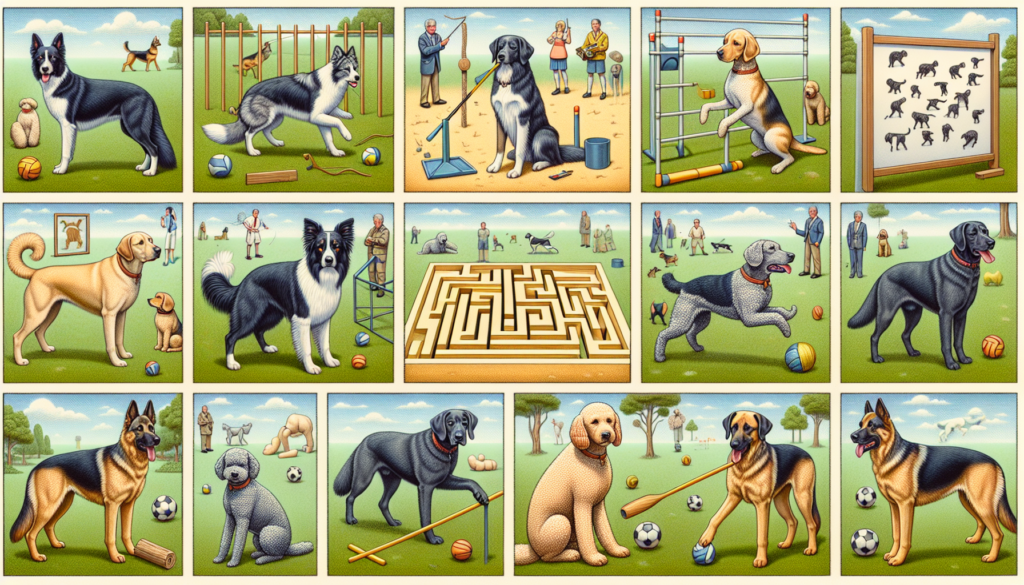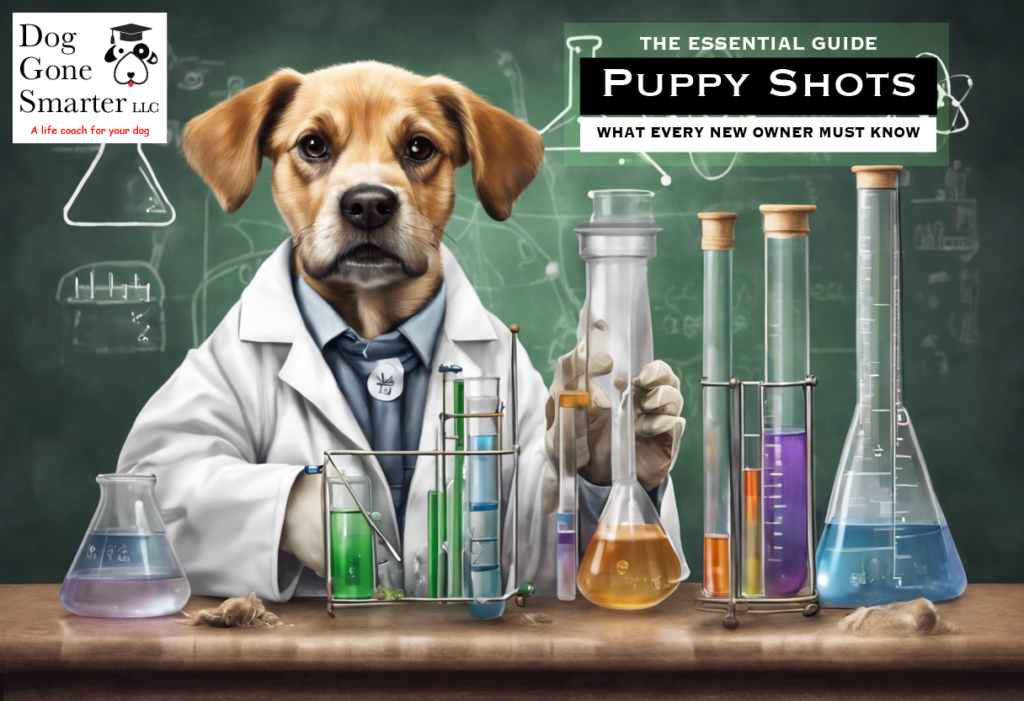The Ultimate Guide to Smart, Fun, and Engaging Dog Games for Training
Dog training games enhance a dog’s life and build real-life skills [1]. Games-based methods replace pain, punishment, and ignoring unwanted behavior [2]. Concept-based training leads to effective learning and easy transfer to everyday life [3]. Games-based training success has been seen in puppy classes [4], and pattern games have been added to behavior training skills [5]. Blending patterns, games, and concept training improve the overall training experience [6].
Dog training games make your dog smarter by providing fun and educational toys and games [7]. These engaging dog brain games provide mental stimulation and strengthen the bond between you and your furry companion. In this ultimate guide, we’ll explore various types of dog games that boost intellectual stimulation, obedience training, physical fitness, and sensory enhancement, all while having a blast with your four-legged friend.
The Benefits of Dog Training Games
Dog training games provide an engaging and motivating way to learn, using fun activities to build real-life skills and focusing on concepts rather than individual actions [1] [2]. Play can increase engagement and focus in training activities, acting as a reinforcing consequence for desired behaviors [3]. It also strengthens the bond between the owner and the dog, providing various benefits such as releasing energy, mastering new concepts, and conflict resolution [4] [13] [18].
Game-Based Dog Training encourages dogs to problem-solve and make good behavioral choices, improving their relationship with the owner [5]. These games teach valuable lessons and help dogs become upstanding members of society [6]. For example:
- Target training builds confidence in dogs, provides a starting point for other training and tricks, and improves recall [7].
- Training provides mental stimulation, preventing destructive behavior caused by boredom, and teaches dogs how to socialize [9].
- Training keeps your home and family safe by teaching a dog to change unwanted behaviors [10].
- Professional dog training provides consistency, helping dogs learn faster [11].
Food rewards and games/toys yield positive correlations with desired dog behaviors [20]. Dogs learn from experiences and respond to cause-effect, with immediate rewards reinforcing desired behaviors [21] [22]. However, dogs don’t automatically understand human rules and verbal commands, and responding to unwanted behavior with rewards can reinforce those behaviors [23] [24]. Intermittent rewards can make behaviors persist, and high-arousal behaviors should have rules and be balanced with control [25] [26]. Training should occur at transition points and become the dog’s idea, with consistency being key [27] [28].
Boosting Mental Stimulation with Puzzle Games
Puzzle games are an excellent way to boost your dog’s mental stimulation and keep them engaged. These games encourage problem-solving skills and can help prolong treat consumption [8]. Food dispensing toys, such as Kongs stuffed with peanut butter or a mixture of wet dog food and treats, are a great example of puzzle games that emulate natural instincts and provide mental stimulation [9] [10].
Here are some simple DIY puzzle games you can create at home:
- Simple Treat Puzzle: Use a plastic container with a lid and cut a few holes in the lid or sides of the container. The holes should be big enough for dog food pieces to pass through but not so large that a lot are dispensed at one time. Put a handful of kibble in the bowl and close the lid [11].
- Destruction Toy: Use an empty cereal or cracker box and remove the plastic liner. Add a few treats or dog kibbles to the box and fold it closed (or use a small amount of tape). Present the box to your dog [11].
- Tennis Ball Treat Puzzle: Using a knife, cut an X shape or a flap in a tennis ball. Place a few pieces of kibble in the ball and give it to your dog [11].
Other puzzle game options include:
- Treat Balls: Hollow balls filled with treats such as kibble, bites of cheese, a frozen bit of yogurt, or a glob of peanut butter [13].
- Puzzle Trays: Cognitive puzzles designed with niches and compartments that dogs may need to nudge, twist, tap, remove, or spin to open and release hidden treats [13].
- Nina Ottossen Puzzle Toys: These are commercially available puzzle toys designed to challenge dogs mentally [14].
Mental stimulation puzzle games are beneficial for dogs of all ages, aiding in the development of puppies, keeping adult dogs stimulated, and helping senior dogs stay alert and active [8]. These games can help improve concentration, memory, and problem-solving skills while fighting boredom [19]. It is recommended that a minimum of 30 minutes of mental stimulation per day be provided, split between two 15-minute sessions, although the amount may vary depending on the breed and energy level of the dog [19].
Understanding Service Animals: The Role of Emotional Support Dogs in Oregon
Emotional Support Animals (ESAs) serve an instrumental role in the lives of individuals facing mental…
Decoding Canine Intelligence: How Do Dog Breeds Compare?
Through millennia of breeding, dogs have evolved to possess three distinct types of intelligence: instinctive,…
The Essential Guide to Puppy Shots: What Every New Owner Must Know
Getting a new puppy is an exciting experience, but it also comes with a lot…
LIFE Dog Training: An Evolution of LIMA Dog Training?
In the dog training world, a paradigm shift has been underway, moving toward more humane…
Canine Separation Anxiety: Treatment Options
Separation anxiety in dogs is a common and distressing behavioral issue that affects a significant…
Choosing a Safe Flea Medicine
What You Need to Know: Selecting the Safest Flea Medicine for Dogs Selecting the safest…
Brain Training Games for Intellectual Stimulation
Brain training games are an excellent way to challenge your dog’s memory, attention, and problem-solving skills. These games encourage independent thinking and help your dog learn new tricks, keeping them mentally stimulated and engaged [8]. Some popular brain training games include:
- Treasure Hunt: Hide treats around the house or garden for your dog to find using their sense of smell [19].
- Three Cups: Place a treat under one of three upturned cups and shuffle them around, allowing your dog to choose the correct cup [8].
- Find the Toy: Encourage your dog to search for a specific toy, rewarding them with praise, treats, or a quick tug-of-war game [8].
- Name that Object: Teach your dog to recognize objects by name, associating the object with a unique word [23].
- Hide and Seek: Hide and let your dog seek you, providing treats, praise, and excitement when they find you [8] [13].
Other engaging brain training games include the Muffin Tin Game, where you hide treats in a muffin tin with objects covering them [8], and the Shell Game, where you hide a ball or treat under one cup while moving around several empty cups as distractions [13] [14]. Trick training is another way to stimulate your dog’s mental muscles, teaching them fun tricks like balancing a treat on their nose to improve patience and focus [13] [16].
The Name Game is a particularly useful brain training game that helps dogs generalize learned behaviors and focuses on getting their attention, which is especially beneficial in new environments with unfamiliar smells or sounds [21]. Family Circle is another game that teaches dogs to find a specific person based on their name, providing mental stimulation and exercise without much effort [22]. As your dog masters these games, you can increase the difficulty by adding more complex tricks or obstacles, ensuring that their brain remains challenged and engaged [15] [24] [25].
Obedience Training Through Play
Obedience training through play is an effective way to teach your dog essential skills while keeping the experience enjoyable and engaging. One popular game is the obstacle course, where you arrange safe obstacles for your dog to navigate, improving their agility and obedience [8]. Before starting, practice training behaviors using a treat pouch and have a clear idea of what you want to train [14]. It’s also essential to practice husbandry and handling, such as getting your dog used to being touched and handled [15], and to work on basic obedience skills and consider incorporating tricks [17].
The Name Game is a crucial exercise that helps dogs generalize learned behaviors and focus on their owners in various environments [21]. Other important games include:
- The Shadow Game: Encourages dogs to follow their owners in different directions and speeds, rewarding them with treats when they catch up [21].
- The Give Game: Teaches dogs to give an item in their mouth in exchange for a treat, preparing them for unexpected situations [21].
- Hide and Seek: Teaches dogs to remain calm and use their senses to seek out their owners in new environments [21].
- The Find the Toy Game: Encourages dogs to use their senses and problem-solving skills to find a hidden toy [21].
- The Follow Your Nose Game: Following a scent trail helps dogs develop their scenting abilities [21].
- The Return to Sender Game: Teaches dogs to bring an item back to you after retrieving it [21].
Other engaging games suitable for puppies, adult dogs, and older dogs include [26]:
- Chase Me: Improves recall by having the dog chase the owner.
- Puppy in the Middle: Teaches puppies to respond to everyone and strengthens recall.
- Name Game: Teaches dogs their name and improves recall.
- Hide and Seek: Improves recall and searching skills.
- Touch: Teaches dogs to touch the handler’s hand, which is useful for building a visual recall.
- Straight Line Walking: Improves lead walking by having the dog walk in a straight line.
- Heel Work: Improves lead walking and recall by having the dog stay close to the handler.
- Figure of 8: Improves lead walking by having the dog walk in a figure of 8 pattern.
- Unpredictable Walking: Improves lead walking by having the handler walk unpredictably.
Tug games, when played with rules such as stopping the game if teeth touch the skin, do not cause dogs to become dominant or aggressive. These games can be an enjoyable way to teach self-control and the ‘drop’ command [7] [22]. The Give command is essential for safe and enjoyable interactions between dogs and their owners, teaching dogs to drop items in their mouth on command [21]. Red Light, Green Light is another game that teaches dogs to listen to cues even when excited, improving impulse control, and can be played in different ways to suit different dogs [22].
DIY Dog Training Games
Creating your own dog training games at home is a fun and cost-effective way to keep your furry friend mentally stimulated and engaged. Here are some easy DIY dog training games you can try:
- Muffin Tin Game: Hide treats in a muffin tin covered with various objects, encouraging exploration [8]. You can also try the Muffin Tin Shell Game by placing a ball in each cup of a muffin tin and hiding treats underneath. Your dog must remove each ball to find the treat [27].
- Toilet Tube Treat Dispensers: Empty toilet paper tubes or paper towel rolls can be stuffed with soft treats, such as peanut butter or cream cheese, for your dog to lick out [27].
- Shoebox Hide and Seek: Place containers in a group on the floor, bait one or a few with smelly treats and allow your dog to sniff and search for the hidden treasure [27].
- Doggy Ball Pit: Fill a plastic kiddie pool with balls and sprinkle kibble or treats on top. Your dog will have to search for the treats as the balls shift positions [27].
- Tea Towel Snuffle Mat: Lay a towel flat on the floor, place treats in the center, fold the towel lengthways, and tie it in a loose knot. Your dog will have to untie the tea towel to get the treats [27]. You can also make a more elaborate snuffle mat using a rubber doormat and fleece material [12].
Other DIY dog training games include:
- Blanket Fold and Treats: Fold a blanket like an accordion, place treats in the folds, and secure the ends with elastics. Your dog will have to find the treats [28].
- Tennis Ball in Muffin Tin Toy: Place semi-moist treats in muffin tin holes and cover them with tennis balls. Your dog needs to bat the balls out of the way to get to the treats [12].
- Recycled Containers: For DIY dog training games, use egg cartons, plastic containers with paper and elastic bands, or bottles with holes [12].
- DIY Bottle Treat Dispenser: Cut holes in a plastic bottle, thread a string through, and load it with kibble or treats. Encourage your dog to figure out how to get the treats [29].
- PVC Pipe Puzzle: Use a 2-inch PVC pipe, cap, and adapter fitment with a threaded cap. Drill holes and attach the end cap and adapter fitment with adhesive. Add dog treats through the threaded cap end [30].
- Sweet Potato Chew Toy: Cut holes in several pieces of dehydrated sweet potato rounds and tie them onto a rope like a beaded necklace [30].
- Bottle Spinning Toy: Build a structure with soda bottles and a dowel, ensuring the bottles spin and dispense treats [30].
You can also create obstacle courses at home using everyday items like cardboard boxes, hula hoops, pillows, brooms, chairs, step stools, sheets, and ironing boards [14] [16]. Building an at-home agility course can help build confidence and trust, increase body awareness, and be made using safe, stable items [7].
Indoor Dog Training Games for Bad Weather
When the weather outside is not conducive to outdoor play, there are plenty of engaging indoor dog training games that can keep your furry friend mentally stimulated and entertained. Here are some fun ideas to try:
- Treasure Hunt: Hide treats around the house for your dog to find using their keen sense of smell. Start with easy hiding spots and gradually increase the difficulty as your dog becomes more skilled at the game [8].
- Find the Toy: Encourage your dog to search for a specific toy, progressively increasing the hiding difficulty. This game helps improve your dog’s sniffing and scavenging abilities while providing mental stimulation [8] [9].
- Hide and Seek: Hide from your dog and encourage them to find you. This classic game not only provides mental stimulation but also strengthens the bond between you and your furry companion [8] [14] [18].
Other indoor activities to keep your dog entertained include:
- Playing with dog-friendly bubbles [16]
- Engaging in tug-of-war, fetch, or indoor soccer [16]
- Having a spa day with bathtime products, a facial, and a pawdicure [16]
- Taking fun and creative photos of your dog in various outfits and scenarios [16]
- Teaching your dog to clean up their toys [17]
For dogs that enjoy climbing, consider using a durable product like Canine Climbing for indoor use. Sending your dog from one climb to another can provide good cardio exercise [33].
Remember, the key to keeping your dog engaged and mentally stimulated during bad weather is to play with them every day, be silly, consensual, and use your imagination [14]. Games can be adapted to suit different weather conditions and your dog’s preferences [22].
Outdoor Dog Training Games for Physical Fitness
Outdoor activities provide excellent opportunities for physical fitness and bonding with your furry friend. Hiking is a great way to explore nature together while promoting a strong connection between you and your dog [33]. Wandering Walks, where you choose a different path each time, expose your dog to new sights, sounds, and smells, providing a fun and rewarding form of enrichment [13].
Setting up an obstacle course in your yard using items like cones, hoops, and tunnels is another engaging way to exercise your dog both physically and mentally [13] [34]. Incorporate hurdles, balance beams, and different obstacles for your dog to navigate, creating a fun puzzle that exercises different joints and muscles [13]. Agility courses are particularly suitable for high-energy dogs, helping to channel their energy in a fun and creative way [25].
Other enjoyable outdoor activities include:
- Frisbee: Toss a frisbee and encourage your dog to catch it [34].
- Bubble Chasing: Buy special dog-friendly bubbles and blow them for your dog to chase [34].
- Catch Me If You Can: Run away, dropping treats on the ground, encouraging your dog to follow and improve attention [33].
- Doggy Play Dates: Schedule play dates with other dog owners for socialization and exercise [16].
- Dog-Friendly Outings: Visit dog-friendly breweries or stores for a change of scenery [16].
Canine conditioning and body awareness exercises can also be incorporated into outdoor play to strengthen your dog and teach them independent body awareness, helping to prevent injuries [33]. Connection Course Cards are another tool for authentic behavior training, promoting relaxation and natural behavior in dogs during outdoor activities [33].
Games to Strengthen the Dog-Owner Bond
Dog training games are an excellent way to strengthen the bond between you and your furry companion. Target training, for instance, can build confidence in dogs, especially those that are worried about touch or coming from uncertain backgrounds [1] [6]. It can also improve a dog’s relationship with its owner and be a starting point for other training and tricks [2] [7]. Target training can be used for various objects and behaviors, such as teaching a dog to go to a mat and lie down, put its paw on something, or rest its chin on something [3]. It can also teach a dog to follow the stick, touch the object, and move in different directions [4], making it useful for teaching tricks, walking close beside the owner, and even teaching a dog to shut doors [5].
Tug of War with a twist is another great game that not only provides a physical workout but also adds an extra layer of mental engagement [8]. To play this game effectively, keep the following rules in mind:
- The human initiates and stops the game, reinforcing human control over the game and the dog’s behavior [9].
- Rover must work for the privilege to play, such as by sitting or lying down before initiating play [10].
- Stop play before Rover gets too riled up to maintain control and prevent over-excitement [11].
- Supervise children’s play with dogs to ensure safety and prevent rough play [12].
Tug of War strengthens the bond between the owner and the dog while also sharpening the dog’s mind and body [19].
Other engaging games that can enhance the dog-owner bond include:
- Hide and Seek: This game involves hiding from the dog and calling them, boosting recall and problem-solving skills [13] [14] [18].
- The Shadow Game: This game teaches recall and polite walking and can be played with or without a leash [15].
- Return to Sender: Teaches dogs to bring an item back to the owner and can be played with a ball or a favorite toy [16].
- Fetch is a cooperative activity that provides mental stimulation and exercise. It teaches dogs to drop an item upon request and transitions between high arousal and calmness [17].
- Chase (you): This game teaches dogs to move towards their owner instead of away, improving recall training. However, it should not be played with children unless the dog has a proven record of being able to handle it without becoming overstimulated [20].
Games to Enhance Your Dog’s Senses
Engaging your dog’s senses through various games is an excellent way to provide mental stimulation and strengthen your bond. Here are some fun games that focus on enhancing your dog’s sensory abilities:
- Three Cups: This game involves hiding a treat under one of three upturned cups, shuffling them, and allowing your dog to choose the correct cup [8]. It tests your dog’s concentration and encourages them to use their sense of smell to locate the treat [10].
- The “Go Find It” Game: Hide a treat or toy in a room and encourage your dog to find it using their keen sense of smell [10]. Start with easy hiding spots and gradually increase the difficulty as your dog becomes more skilled at the game.
- Scent Trail: Create a scent trail for your dog to follow by placing treats along a path or hiding them in different locations [10]. This game taps into your dog’s extraordinary sense of smell and provides mental stimulation as they navigate the trail to find the rewards.
By incorporating these sensory-focused games into your dog’s playtime routine, you can help them develop their natural abilities while providing a fun and engaging experience. Remember to always praise and reward your dog for their efforts, reinforcing their learning and strengthening your bond [8] [10].
Games You Should Avoid Playing with Your Dog
While playing games with your dog can be a fun and rewarding experience, it’s essential to be aware of certain activities that may be harmful or detrimental to your furry friend’s well-being. Here are some games and toys to avoid:
- Rough play, such as wrestling or tug-of-war, can be confusing for dogs and may lead to misunderstandings regarding threatening behavior. Encourage toy-focused play to ensure your dog understands the playful context [11].
- Avoid dominance games with a puppy, such as tug-of-war, unless you can win every time. Do not engage in rough play with your dog using your body; instead, always use toys. Never allow a dog’s teeth to make contact with a human, even unintentionally. Monitor dog-to-dog play and intervene if it becomes too rough or aggressive. Keep toys below waist height to discourage jumping up. Do not force a dog to play when they do not want to. Supervise dog play, especially with children present, and ensure that all interactions are gentle and safe [11].
- Steer clear of toys that can be harmful to your dog’s health:
- Avoid toys that are harder than your dog’s teeth, such as antlers, nylabones, natural bones, and ice, as they can break teeth and cause microfractures of the enamel. Use the fingernail test: if you cannot press your fingernail into it, it is likely too hard for your dog to chew on [6].
- Avoid chews that can be contaminated with bacteria, such as pig ears, bully sticks, rawhide, and jerky chews, as they can contain salmonella or e.coli [7].
- Avoid toys that are too small or contain small pieces that can be ingested, such as stuffed toys, rope toys, and small tennis balls, as they can cause intestinal blockages and linear foreign bodies [8].
- Avoid sticks, as they can splinter and get lodged in the throat, causing injury or perforation to the mouth, intestines, or even the heart [9]. Sticks can lead to severe injuries, including eye damage and splinters in the mouth that may require expensive medical treatment. Instead of throwing sticks, consider using a rubber stick or distracting your dog with a treat to discourage stick-related behaviors [12].
- Balls should be appropriately sized to prevent choking hazards. Tennis balls can be particularly harmful in sandy or gritty environments due to their abrasive fibers, which can damage teeth and lead to expensive surgeries [13].
When exercising puppies, avoid games that can be harmful to growing bones and joints [6]. Monitor for signs of fatigue during exercise and immediately stop and offer rest if your dog appears out of breath or repeatedly tries to sit or lie down [6].
Conclusion
In conclusion, dog training games offer many benefits for you and your furry companion. By incorporating a variety of engaging activities that target mental stimulation, obedience, physical fitness, and sensory enhancement, you can help your dog lead a happy, healthy, and well-rounded life. These games provide entertainment and strengthen the bond between you and your dog, fostering a deeper understanding and connection.
As you embark on this journey of training through play, remember always to prioritize your dog’s safety and well-being. Avoid games that may be harmful or confusing, and opt for activities that promote positive reinforcement and encourage your dog’s natural abilities. With patience, consistency, and a spirit of fun, you and your furry friend can enjoy countless hours of meaningful play while building a strong foundation of trust and companionship.
FAQs
What is the ‘1 2 3’ method in dog training?
The ‘1 2 3’ dog training method is a technique not described here. For more information on this method, you may need to look for resources that specialize in dog training techniques.
How can I provide entertainment for my intelligent dog?
To keep a smart dog entertained, you’ll need to introduce new activities frequently to challenge them. Some suggestions include:
- Hiding treats around your home for your dog to find.
- Filling a Kong toy with peanut butter.
- Using a snuffle mat to engage their sense of smell.
- Going on regular outings with your dog for new experiences.
- Playing hide and seek stimulates their problem-solving skills.
- Providing a pop-up tunnel for physical play and exploration.
Do mental stimulation games help to exhaust a dog?
Yes, interactive brain games can effectively tire out an energetic dog. These activities combat boredom and boost your dog’s confidence and enhance the bond you share by encouraging teamwork.
Which brain games are considered the best for dogs?
Some of the top brain games for dogs that provide mental stimulation include:
- Teaching your dog new tricks.
- Playing the ‘Three Cups’ game.
- Encouraging independent thinking through advanced brain games.
- ‘Find the Toy’ to bolster their search and retrieval skills.
- The ‘Muffin Tin’ game for problem-solving.
- ‘Name That Object’ to improve their vocabulary and recognition.
- Setting up an obstacle course for physical and mental challenges.
- Engaging in hide and seek offers ample mental stimulation.
References
[1] – https://gentletouchdogtrainingblog.wordpress.com/2013/11/16/cause-effect-dog-training-learning-with-games/
[2] – https://www.mdpi.com/2076-2615/14/3/428
[3] – https://dogbehavior.it/dogbehavior/article/view/34
[4] – https://www.ncbi.nlm.nih.gov/pmc/articles/PMC7743949/
[5] – https://inquisitivecanine.com/2008/10/18/dog-play-behavior-are-they-fighting-or-playing/
[6] – https://vcahospitals.com/know-your-pet/dog-behavior-and-training—play-and-exercise
[7] – https://www.cognitivecanineco.co.uk/articles/playing-with-your-dog-5-games-for-a-brilliant-bond
[8] – https://www.purina.co.uk/articles/dogs/behaviour/play/brain-games-for-dogs
[9] – https://www.nylabone.com/dog101/brain-games-for-dogs
[10] – https://www.dogster.com/dog-training/brain-games-for-dogs
[11] – https://www.animalhumanesociety.org/resource/brain-games-dogs
[12] – https://www.youtube.com/watch?v=60elGgvkXJg
[13] – https://allthingswoof.com/blog/62441/fun-cognitive-training-games-for-dogs
[14] – https://tullystraining.com/blog/indoor-dog-activities-to-burn-energy-on-rainy-days
[15] – https://www.youtube.com/watch?v=LPimyV4b0kA
[16] – https://www.sidewalkdog.com/rainy-day-dog-activities/
[17] – https://www.reddit.com/r/dogs/comments/10pbb4g/what_are_some_ideas_to_exercise_dogs_indoors/
[18] – https://www.fourpaws.com/pets-101/family-matters/indoor-dog-games-and-activities
[19] – https://www.barclondon.com/blogs/dog-training-behaviour/brain-games-for-dogs
[20] – https://www.chewy.com/b/puzzle-toys-games-2335
[21] – https://www.releasethehounds.ca/canine-connection-8-fun-games-to-play-with-your-dog/
[22] – https://www.thewildest.com/dog-behavior/enrichment-games-for-dogs
[23] – https://www.akc.org/expert-advice/training/fun-cognitive-training-games-for-dogs/
[24] – https://www.rover.com/blog/awesome-indoor-dog-activities/
[25] – https://kcdawgz.com/top-5-games-for-building-a-closer-bond-with-your-dog/
[26] – https://zigzag.dog/en-us/blog/new-puppy/games-and-toys/puppy-training-games-library/
[27] – https://www.akc.org/expert-advice/lifestyle/do-it-yourself-cognitive-dog-toys-for-home/
[28] – https://www.youtube.com/watch?v=Tx9I2UrCChQ
[29] – https://www.youtube.com/watch?v=7u35OVNX18c
[30] – https://www.impactdogcrates.com/blogs/puppy-news/diy-dog-puzzles
[31] – https://www.pinterest.com/pin/diy-enrichment-games-for-your-dog–411164640962515768/
[32] – https://www.youtube.com/watch?v=It_SOXj7GgY
[33] – https://www.youtube.com/watch?v=t2I-LfF7eL0
[34] – https://www.quora.com/What-are-some-good-outdoor-games-to-play-with-my-dog-if-it-doesnt-know-how-to-play-fetch
[35] – https://www.ncbi.nlm.nih.gov/pmc/articles/PMC7895348/
[36] – https://journeydogtraining.com/13-dog-training-games/

